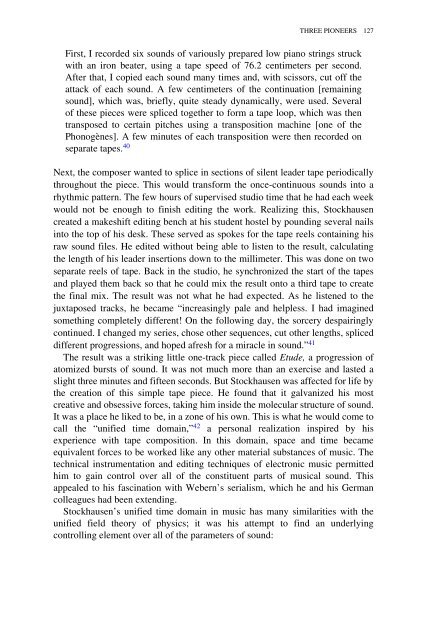Electronic and Experimental Music: Pioneers in ... - Aaaaarg
Electronic and Experimental Music: Pioneers in ... - Aaaaarg
Electronic and Experimental Music: Pioneers in ... - Aaaaarg
You also want an ePaper? Increase the reach of your titles
YUMPU automatically turns print PDFs into web optimized ePapers that Google loves.
THREE PIONEERS 127<br />
First, I recorded six sounds of variously prepared low piano str<strong>in</strong>gs struck<br />
with an iron beater, us<strong>in</strong>g a tape speed of 76.2 centimeters per second.<br />
After that, I copied each sound many times <strong>and</strong>, with scissors, cut off the<br />
attack of each sound. A few centimeters of the cont<strong>in</strong>uation [rema<strong>in</strong><strong>in</strong>g<br />
sound], which was, briefly, quite steady dynamically, were used. Several<br />
of these pieces were spliced together to form a tape loop, which was then<br />
transposed to certa<strong>in</strong> pitches us<strong>in</strong>g a transposition mach<strong>in</strong>e [one of the<br />
Phonogènes]. A few m<strong>in</strong>utes of each transposition were then recorded on<br />
separate tapes. 40<br />
Next, the composer wanted to splice <strong>in</strong> sections of silent leader tape periodically<br />
throughout the piece. This would transform the once-cont<strong>in</strong>uous sounds <strong>in</strong>to a<br />
rhythmic pattern. The few hours of supervised studio time that he had each week<br />
would not be enough to f<strong>in</strong>ish edit<strong>in</strong>g the work. Realiz<strong>in</strong>g this, Stockhausen<br />
created a makeshift edit<strong>in</strong>g bench at his student hostel by pound<strong>in</strong>g several nails<br />
<strong>in</strong>to the top of his desk. These served as spokes for the tape reels conta<strong>in</strong><strong>in</strong>g his<br />
raw sound files. He edited without be<strong>in</strong>g able to listen to the result, calculat<strong>in</strong>g<br />
the length of his leader <strong>in</strong>sertions down to the millimeter. This was done on two<br />
separate reels of tape. Back <strong>in</strong> the studio, he synchronized the start of the tapes<br />
<strong>and</strong> played them back so that he could mix the result onto a third tape to create<br />
the f<strong>in</strong>al mix. The result was not what he had expected. As he listened to the<br />
juxtaposed tracks, he became “<strong>in</strong>creas<strong>in</strong>gly pale <strong>and</strong> helpless. I had imag<strong>in</strong>ed<br />
someth<strong>in</strong>g completely different! On the follow<strong>in</strong>g day, the sorcery despair<strong>in</strong>gly<br />
cont<strong>in</strong>ued. I changed my series, chose other sequences, cut other lengths, spliced<br />
different progressions, <strong>and</strong> hoped afresh for a miracle <strong>in</strong> sound.” 41<br />
The result was a strik<strong>in</strong>g little one-track piece called Etude, a progression of<br />
atomized bursts of sound. It was not much more than an exercise <strong>and</strong> lasted a<br />
slight three m<strong>in</strong>utes <strong>and</strong> fifteen seconds. But Stockhausen was affected for life by<br />
the creation of this simple tape piece. He found that it galvanized his most<br />
creative <strong>and</strong> obsessive forces, tak<strong>in</strong>g him <strong>in</strong>side the molecular structure of sound.<br />
It was a place he liked to be, <strong>in</strong> a zone of his own. This is what he would come to<br />
call the “unified time doma<strong>in</strong>,” 42 a personal realization <strong>in</strong>spired by his<br />
experience with tape composition. In this doma<strong>in</strong>, space <strong>and</strong> time became<br />
equivalent forces to be worked like any other material substances of music. The<br />
technical <strong>in</strong>strumentation <strong>and</strong> edit<strong>in</strong>g techniques of electronic music permitted<br />
him to ga<strong>in</strong> control over all of the constituent parts of musical sound. This<br />
appealed to his fasc<strong>in</strong>ation with Webern’s serialism, which he <strong>and</strong> his German<br />
colleagues had been extend<strong>in</strong>g.<br />
Stockhausen’s unified time doma<strong>in</strong> <strong>in</strong> music has many similarities with the<br />
unified field theory of physics; it was his attempt to f<strong>in</strong>d an underly<strong>in</strong>g<br />
controll<strong>in</strong>g element over all of the parameters of sound:












